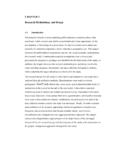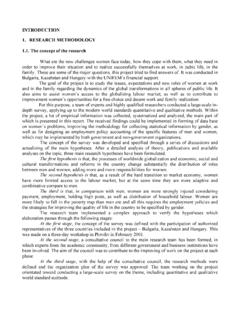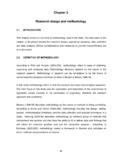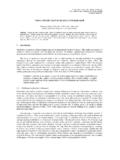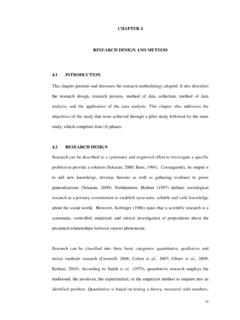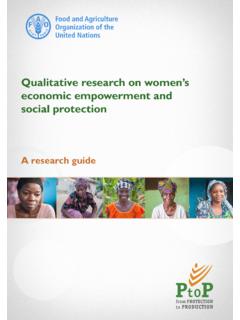Transcription of Introduction to quantitative research - SAGE …
1 8725 25/08/2010 16:36 Page 1. 1. Introduction to quantitative research What is quantitative research ? research methods in education (and the other social sciences) are often divided into two main types: quantitative and qualitative methods. This book will discuss one of these two main strands: quantitative methods', and what distinguishes quantitative from qualitative methods. When you think of quantitative methods, you will probably have specific things in mind. You will probably be thinking of statistics, numbers, and many of you may be feeling somewhat apprehensive because you think quantitative methods are difficult. Apart from the last one, all these thoughts capture some of the essence of quantitative methods. The following definition, taken from Aliaga and Gunderson (2000), describes what we mean by quantitative research methods very well: quantitative research is Explaining phenomena by collecting numerical data that are analysed using mathematically based methods (in particu- lar statistics)'.
2 Let's go through this definition step by step. The first element is explaining phenomena. This is a key element of all research , be it quantitative or quali- tative. When we set out to do some research , we are always looking to explain something. In education, this could be questions like why do teachers leave teaching?', what factors influence pupil achievement?', and so on. The specificity of quantitative research lies in the next part of the defini- tion. In quantitative research , we collect numerical data. This is closely con- nected to the final part of the definition: analysis using mathematically 1. 8725 25/08/2010 16:36 Page 2. 2 DOING quantitative research IN EDUCATION WITH SPSS. based methods. In order to be able to use mathematically based methods, our data have to be in numerical form. This is not the case for qualitative research .
3 Qualitative data are not necessarily or usually numerical, and therefore cannot be analysed by using statistics. Therefore, as quantitative research is essentially about collecting numerical data to explain a particular phenomenon, particular questions seem imme- diately suited to being answered using quantitative methods. How many males get a first-class degree at university compared to females? What per- centage of teachers and school leaders belong to ethnic minority groups? Has pupil achievement in English improved in our school district over time? These are all questions we can look at quantitatively, as the data we need to collect are already available to us in numerical form. Does this not severely limit the usefulness of quantitative research though? There are many phenomena we might want to look at, but which don't seem to pro- duce any quantitative data.
4 In fact, relatively few phenomena in education actually occur in the form of naturally' quantitative data. Luckily, we are far less limited than might appear from the above. Many data that do not naturally appear in quantitative form can be collected in a quantitative way. We do this by designing research instruments aimed specifically at converting phenomena that don't naturally exist in quan- titative form into quantitative data, which we can analyse statistically. Examples of this are attitudes and beliefs. We might want to collect data on pupils' attitudes to their school and their teachers. These attitudes obviously do not naturally exist in quantitative form (we don't form our attitudes in the shape of numerical scales!). Yet we can develop a question- naire that asks pupils to rate a number of statements (for example, I think school is boring') as either agree strongly', agree', disagree' or disagree strongly', and give the answers a number ( 1 for disagree strongly', 4.)
5 For agree strongly). Now we have quantitative data on pupil attitudes to school. In the same way, we can collect data on a wide number of phen- omena, and make them quantitative through data collection instruments such as questionnaires or tests. In the next three chapters, we will look at how we can develop instruments to do just that. The number of phenomena we can study in this way is almost unlimited, making quantitative research quite flexible. This is not to say that all phenomena are best studied by quantitative methods. As we will see, while quantitative methods have some notable advantages, they also have disadvantages, which means that some phenomena are better studied by using different (qualitative) methods. The last part of the definition refers to the use of mathematically based methods, in particular statistics, to analyse the data.
6 This is what people usually think about when they think of quantitative research , and is often 8725 25/08/2010 16:36 Page 3. Introduction TO quantitative research 3. seen as the most important part of quantitative studies. This is a bit of a misconception, as, while using the right data analysis tools obviously mat- ters a great deal, using the right research design and data collection instru- ments is actually more crucial. The use of statistics to analyse the data is, however, the element that puts a lot of people off doing quantitative research , as the mathematics underlying the methods seems complicated and frightening. As we will see later on in this book, most researchers do not really have to be particularly expert in the mathematics underlying the methods, as computer software allows us to do the analyses quickly and (relatively) easily.
7 Foundations of quantitative research methods Realism, subjectivism and the paradigm wars'. Now we have defined quantitative research , it is a good idea to compare it with qualitative research , to which it is usually put in opposition. While quantitative research is based on numerical data analysed statistically, qual- itative research uses non-numerical data. Qualitative research is actually an umbrella term encompassing a wide range of methods, such as interviews, case studies, ethnographic research and discourse analysis, to name just some examples. The difference between quantitative and qualitative research is often seen as quite fundamental, leading people to talk about paradigm wars' in which quantitative and qualitative research are seen as warring and incom- mensurable fractions. Many researchers define themselves as either quanti- tative or qualitative.
8 Where does this idea come from? This idea is linked to what are seen as the different underlying philosophies and world views of researchers in the two paradigms' (also called episte- mologies'). According to this view, two fundamentally different world views underlie quantitative and qualitative research . The quantitative view is described as being realist' or sometimes positivist', while the world view underlying qualitative research is viewed as being subjectivist'. What does this mean? Realists take the view that what research does is uncover an existing reality. The truth is out there', and it is the job of the researcher to use objective research methods to uncover that truth. This means that the researcher needs to be as detached from the research as pos- sible, and use methods that maximise objectivity and minimise the involvement of the researcher in the research .
9 This is best done by methods 8725 25/08/2010 16:36 Page 4. 4 DOING quantitative research IN EDUCATION WITH SPSS. taken largely from the natural sciences, which are then transposed to social research settings (such as education). Positivism is the most extreme form of this world view. According to positivism, the world works according to fixed laws of cause and effect. Scientific thinking is used to test theories about these laws, and either reject or provisionally accept them. In this way, we will finally get to understand the truth about how the world works. By developing reliable measurement instruments, we can objectively study the physical world. This view that there is a true reality out there that we can measure completely objectively is problematic. We are all part of the world we are observing, and cannot completely detach ourselves from what we are researching.
10 Historical research has shown that what is studied, and what findings are produced, are influenced by the beliefs of the people doing the research and the political/social climate at the time the research is done. According to this viewpoint, qualitative researchers are subjectivists. In contrast to the realist view that the truth is out there and can be objectively measured and found through research , they point to the role of human subjectivity in the process of research . Reality is not out there' to be objec- tively and dispassionately observed by us, but is at least in part constructed by us and by our observations. There is no pre-existing objective reality that can be observed. The process of our observing reality changes and trans- forms it, and therefore subjectivists are relativistic. All truth can only be rel- ative, and is never definitive, as the positivist claims.











